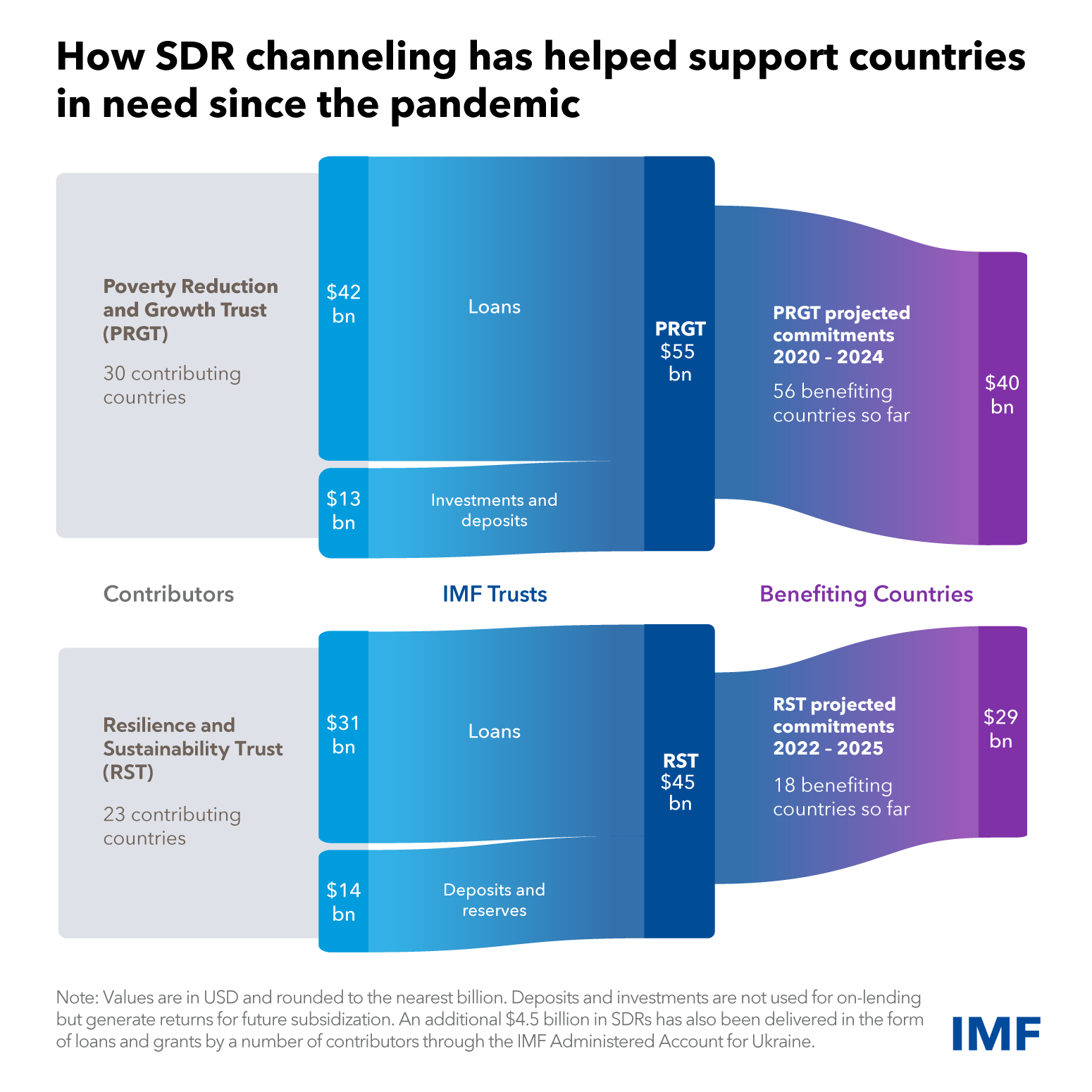
The SDR is an international reserve asset created by the IMF to supplement the official reserves of its member countries.
The SDR is not a currency. It is a potential claim on the freely usable currencies of IMF members. As such, SDRs can provide a country with liquidity.
A basket of currencies defines the SDR: the US dollar, Euro, Chinese Yuan, Japanese Yen, and the British Pound.

Since the onset of the pandemic, SDR channeling (and equivalent currency amounts) has helped many countries in need, especially those eligible for financial support from the IMF’s Poverty Reduction and Growth Trust (PRGT) and the Resilience and Sustainability Trust (RST).
Since 2020, channeling of $55 billion is providing the PRGT with the capacity to mobilize $40 billion in interest-free loans to our poorest members through 2024. This financing helps support growth enhancing reforms in these countries. So far, these loans have benefited 56 countries and could benefit more in the years ahead.
Channeling has also supported the operations of the RST, which delivers affordable long-term financing to help vulnerable countries tackle long-term challenges including climate change. To date, 23 RST partners have channeled about $45 billion to the RST, which is expected to contribute toward meeting an estimated $29 billion in affordable financing.

A technical assistance (TA) mission on external sector statistics (ESS) was conducted for the Andorran Statistics Department (ASD) in the Principality of Andorra in March and April 2022. The mission focused on initiating the compilation of international investment position (IIP) and in producing balance of payments statistics regularly with an improved coverage and quality. The mission also assisted the ASD in developing the new direct reporting system, which will be used as one of the main source data for compiling balance of payments statistics and IIP annually.
After a remarkable recovery, the Andorra economy continues to grow slightly above potential despite significant external headwinds. Headline inflation is elevated amidst persistent core inflation and a tight labor market. The banking sector remains profitable, well-capitalized, and liquid.
The new trade and labor migration patterns that emerged since the start of Russia’s war in Ukraine have provided an unexpected boost to growth. Tax revenue increased considerably since 2021, public debt declined below 50 percent of GDP by end-2022, and inflation while still elevated has decelerated into the single digits in 2023. The authorities should take advantage of these generally favorable macroeconomic conditions to strengthen their policy framework and advance structural reforms on multiple fronts to build resilience, support higher and more inclusive growth, and mitigate the risks from heightened global uncertainty.
Growth is estimated to have reached 4.8 percent in 2023 and is projected to slow to 3.1 percent in 2024. Inflation declined to 9.8 percent in 2023, still well above the National Bank of Kazakhstan (NBK)’s target of 5 percent. Risks to the outlook are tilted to the downside. The state’s footprint in the economy remains large and structural reform implementation has been slow in recent years. Despite strong buffers, the economy needs to be better prepared for future shocks in both the short term (e.g., from war spillovers, inflation, and global economic and financial conditions) and the medium term (e.g., from geo-economic fragmentation, climate events, and global decarbonization).
Equatorial Guinea’s macroeconomic situation has deteriorated over the last decade due to a secular decline in oil production. In 2022, economic indicators improved somewhat. However, this recovery was short-lived, with the economy projected to fall back into recession in 2023. In the years ahead, the economy would contract further. Without strong policy responses, all the gains in per capita income achieved over the last two decades are expected to fully unravel by 2028. The three-year Extended Fund Facility (EFF) approved in 2019 to support the authorities’ diversification agenda expired at end-2022 without a single completed review. The authorities have nonetheless continued to implement reforms delayed under the program as well as the 2022 Article IV Consultation recommendations.
The Nicaraguan economy remained resilient through multiple shocks over the past five years, supported by appropriate policies, substantial pre-crisis buffers (primarily government deposits), and multilaterals support. After a strong rebound in 2021, the economy continued to grow at a steady pace in 2022 and through June 2023 (3.8 percent). Inflation slowed down, the fiscal position turned into a surplus, and record-high remittances, sustained Foreign Direct Investment (FDI) and prudent policies supported a continued accumulation of gross international reserves. Banks remain well capitalized, and the loan portfolio is steadily improving with the economic recovery.
A technical assistance (TA) mission on external sector statistics (ESS) was conducted for the Andorran Statistics Department (ASD) in the Principality of Andorra in March and April 2022. The mission focused on initiating the compilation of international investment position (IIP) and in producing balance of payments statistics regularly with an improved coverage and quality. The mission also assisted the ASD in developing the new direct reporting system, which will be used as one of the main source data for compiling balance of payments statistics and IIP annually.
After a remarkable recovery, the Andorra economy continues to grow slightly above potential despite significant external headwinds. Headline inflation is elevated amidst persistent core inflation and a tight labor market. The banking sector remains profitable, well-capitalized, and liquid.
The new trade and labor migration patterns that emerged since the start of Russia’s war in Ukraine have provided an unexpected boost to growth. Tax revenue increased considerably since 2021, public debt declined below 50 percent of GDP by end-2022, and inflation while still elevated has decelerated into the single digits in 2023. The authorities should take advantage of these generally favorable macroeconomic conditions to strengthen their policy framework and advance structural reforms on multiple fronts to build resilience, support higher and more inclusive growth, and mitigate the risks from heightened global uncertainty.
Growth is estimated to have reached 4.8 percent in 2023 and is projected to slow to 3.1 percent in 2024. Inflation declined to 9.8 percent in 2023, still well above the National Bank of Kazakhstan (NBK)’s target of 5 percent. Risks to the outlook are tilted to the downside. The state’s footprint in the economy remains large and structural reform implementation has been slow in recent years. Despite strong buffers, the economy needs to be better prepared for future shocks in both the short term (e.g., from war spillovers, inflation, and global economic and financial conditions) and the medium term (e.g., from geo-economic fragmentation, climate events, and global decarbonization).
Equatorial Guinea’s macroeconomic situation has deteriorated over the last decade due to a secular decline in oil production. In 2022, economic indicators improved somewhat. However, this recovery was short-lived, with the economy projected to fall back into recession in 2023. In the years ahead, the economy would contract further. Without strong policy responses, all the gains in per capita income achieved over the last two decades are expected to fully unravel by 2028. The three-year Extended Fund Facility (EFF) approved in 2019 to support the authorities’ diversification agenda expired at end-2022 without a single completed review. The authorities have nonetheless continued to implement reforms delayed under the program as well as the 2022 Article IV Consultation recommendations.
The Nicaraguan economy remained resilient through multiple shocks over the past five years, supported by appropriate policies, substantial pre-crisis buffers (primarily government deposits), and multilaterals support. After a strong rebound in 2021, the economy continued to grow at a steady pace in 2022 and through June 2023 (3.8 percent). Inflation slowed down, the fiscal position turned into a surplus, and record-high remittances, sustained Foreign Direct Investment (FDI) and prudent policies supported a continued accumulation of gross international reserves. Banks remain well capitalized, and the loan portfolio is steadily improving with the economic recovery.